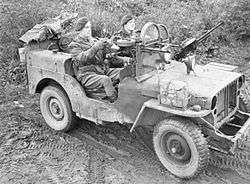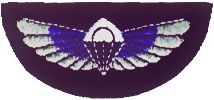5th Special Air Service
| 5th Special Air Service | |
|---|---|
|
Crest and Cap Badge of the 5th Special Air Service | |
| Active | February 1941 – 21 September 1945 |
| Country |
|
| Type | Special Forces |
| Size |
One squadron (until early 1945) One regiment (from March 1945) |
| Part of | Free Belgian Forces (British Army) |
| Garrison/HQ |
Malvern Wells Loudon Castle Camp Tervuren |
| Motto(s) | Who Dares Wins |
| March |
Quick: Marche des Parachutistes Belges Slow: Lili Marlene |
| Battle honours |
Normandy - Belgium - Ardennes - Emden - Oldenburg Fourragère of the Leopold Order Fourragère of the French Croix de Guerre 1939-1945 |
| Commanders | |
| Notable commanders | Lieutenant Colonel Eddy Blondeel |
The 5th Special Air Service or 5th SAS was an elite airborne unit during World War II, consisting entirely of Belgian volunteers. It saw action as part of the SAS Brigade in Normandy, Northern France, Belgium, the Netherlands and Germany. Initially trained in sabotage and intelligence gathering, they converted to motorised reconnaissance on armoured jeeps. They were noted for being the first Allied unit to set foot onto Belgian soil and the first to cross the Siegfried line. This latter feat although was merely accomplished by accident.[1][2]
History
A Belgian Independent Parachute Company was officially installed at Malvern Wells (Worcestershire) on the 8th of May 1942 by Henri Rolin, the then-Belgian undersecretary for defence. It comprised the following:
- A Company 2nd Battalion Belgian Fusiliers, a Battalion mainly made up of Belgian volunteers from South and North America assembled since January 1941, who moved to Great Britain in June 1941. "A" Company as a whole had volunteered in February 1942 to train on the lines of an Independent Parachute Company under Lt. Freddy Limbosch as Chief Instructor.
- A platoon of the 1st Battalion Belgian Fusiliers with some qualified parachutists (since January 1942).
- Volunteers from other units of the Belgian Forces who had escaped from occupied Belgium via France, Spain and Gibraltar.
The newly formed Company continued to train as an Independent Parachute Company making extensive use of the many schools and training facilities offered by the British (the first Parachutists wings worn by Belgians were earned at Ringway parachute school in early 1942).
The unit was attached for 3 months to the 8th Parachute Battalion of the 6th Airborne Division in 1943, then spent a month intensive training in December 1943 at the 'Allied Training Centre' Inverlochy Castle (Fort William), and finally moved, in February 1944, to Loudon Castle Camp, near Galston (Ayrshire) to join the Special Air Service (S.A.S.) Brigade.[3]
Like all military units and formations the men came from all walks of life and this was especially true with this particular unit. The volunteers included a former world cycling champion, lawyers, farmers, labourers, lumberjacks, a circus acrobat, a professional wrestler and even three bona fide barons. The commanding officer himself was both a qualified engineer and dentist. The men who volunteered came from all four corners of the world to carry on the fight against the Nazis. Not all of them could even speak the same language. Some spoke French, some spoke Dutch while others spoke only English. These differences of upbringing, class, lifestyle and even language might have seemed problematic but a real esprit de corps developed quickly within the unit.

The role of the Belgian SAS parachutists during the Second World War was primarily sabotage, intelligence gathering and reconnaissance. The men saw their first action towards the end of July 1944 in France. During the Ardennes offensive in 1944 the unit was regrouped and equipped with armoured jeeps. As a reconnaissance squadron, they executed security and reconnaissance missions in order to support the 6th British Airborne Division. They did so during the tough fighting during the Battle of Bure. In 1945 they were used for counter-intelligence work which involved the location and arrest of top-ranking Nazis and war criminals.
In the beginning of April 1945 the Belgian SAS Squadron consisted of three reconnaissance squads which were deployed in the north of Holland and in Germany. After the capitulation of the Germans on the 8th of May 1945 the Belgian SAS participated in 'Counter Intelligence' missions in both Germany and Denmark.
At the end of the war the Belgian SAS Regiment had much to be proud of. They had been the first Allied unit to set foot in Belgium and Germany and the only Belgian unit permanently on active deployment between July 1944 and May 1945. They had also been responsible for the capture of Admiral Doenitz's government in Flensburg and the German Foreign minister Ribbentrop.[4]
Insignia

- The cap badge is a downward pointing flaming sword worked in cloth of a Crusader shield.[5] It was designed by Corporal Robert Tait, MM and Bar, of the London Scottish following the usual British Army practice of holding a competition to design the cap badge for a new unit. The competition was held after the close of Operation Crusader. The motto is Who Dares, Wins. It was approved by the first Commanding Officer David Stirling, with the proposed wording 'Descend to Defend' or 'Strike and Destroy' disallowed. The sword depicted is King Arthur's Excalibur. Erroneous references to it as the Sword of Damocles derive from an article originally published in the regimental journal Mars and Minerva, written by a respected veteran of both British Regiments and the post-war re-raised Regiment. The author was subsequently proved to be incorrect, but the story has been repeated by others.
- The Maroon beret.
- The SAS pattern parachute wings were designed by Lieutenant Jock Lewes and based on the basic British Army design approved in 1940 but modified to reflect the Middle East origins of the new unit by the substitution of the stylised sacred Ibis wings of Isis of Egyptian iconography depicted in the décor of Shepheard's Hotel in Cairo.
Disbandment
On the 21st of September 1945 5th SAS was transferred from the British Army to the newly reformed Belgian Army. Renamed the 1st Regiment of Parachutists they served independently as a highly mobile airborne unit until 1952 when the regiment joined with the Commando Regiment to form a battalion of the Paracommando Regiment. From 1952 on the traditions of 5th SAS were continued by 1st Parachute Battalion (1 PARA) of the Paracommando Regiment.[6]
Amid defense cuts and reorganization to the Belgian army, in 2011 1 PARA was disbanded after 59 years of continuous service. In December 2010 the unit's banner, flag and insignia were officially handed over to the newly formed Special Forces Group (SFG).
See also
References
- ↑ GENOT E. Rode mutsen, Groene Mutsen
- ↑ http://www.ww2f.com/topic/15826-belgian-sas/
- ↑ http://www.belgiansas.com/history.html
- ↑ http://www.belgiansas.com/operations.html
- ↑ Gordon Stevens, The Originals, ISBN 978-0-09-190182-0.
- ↑ http://www.1para.be/
